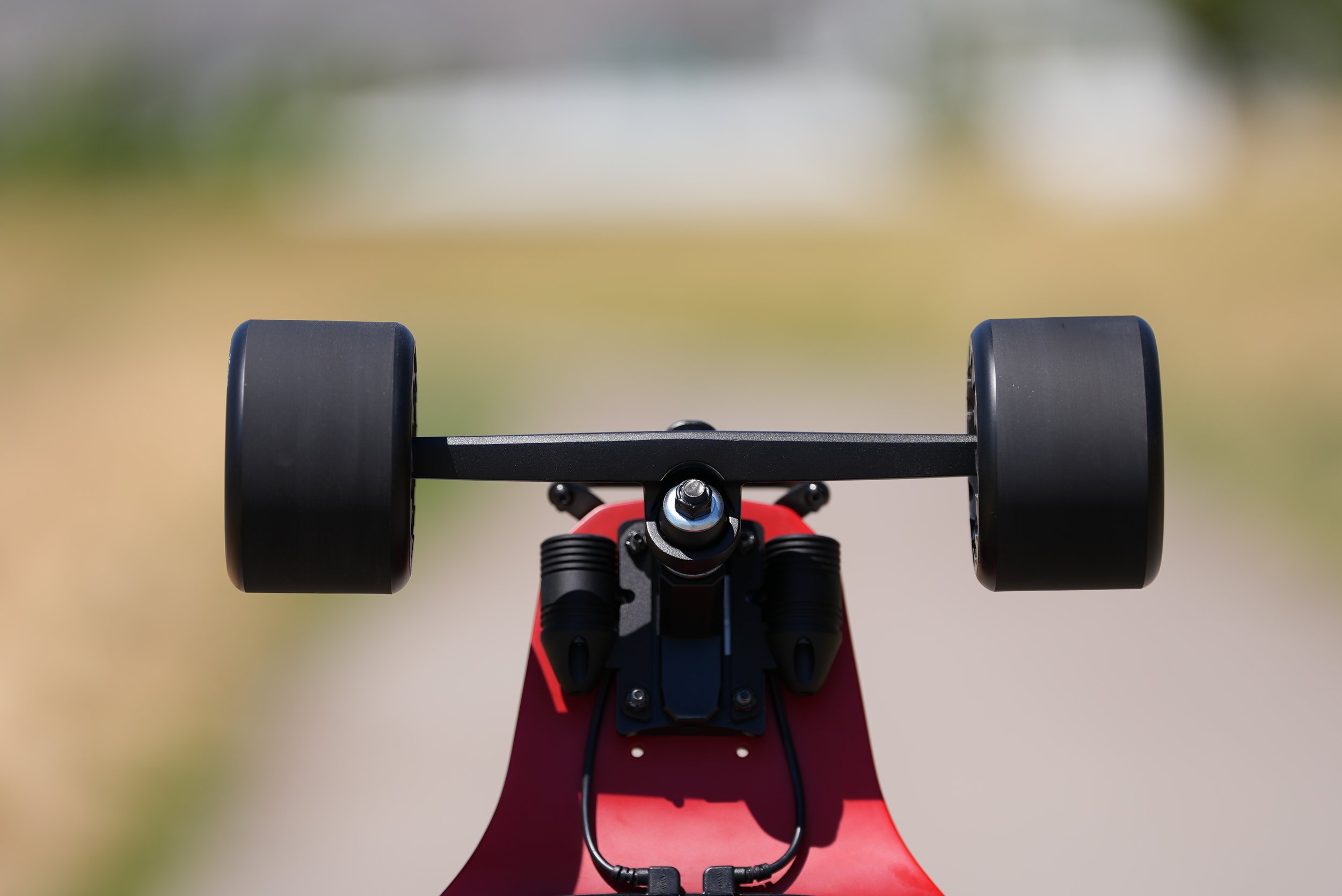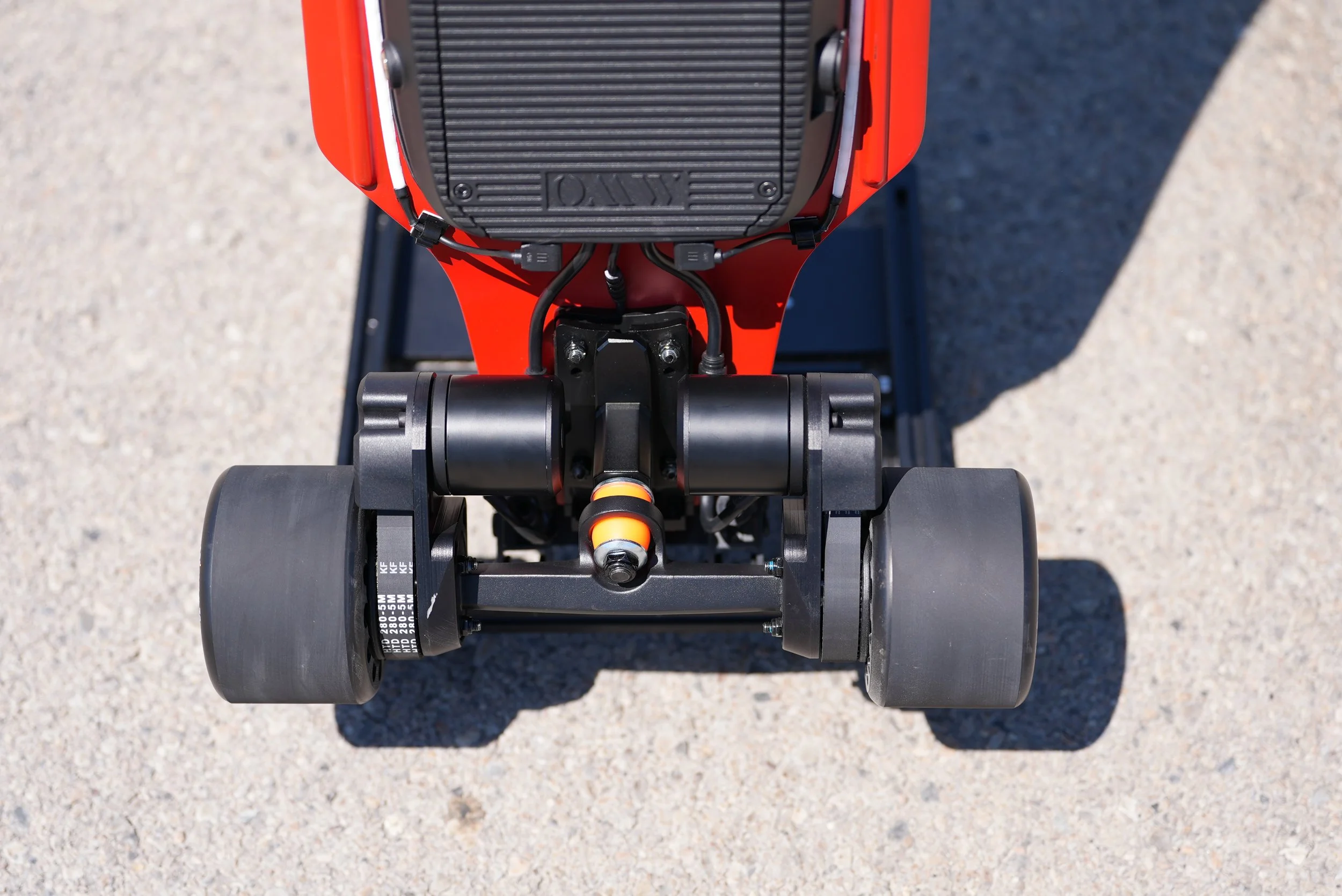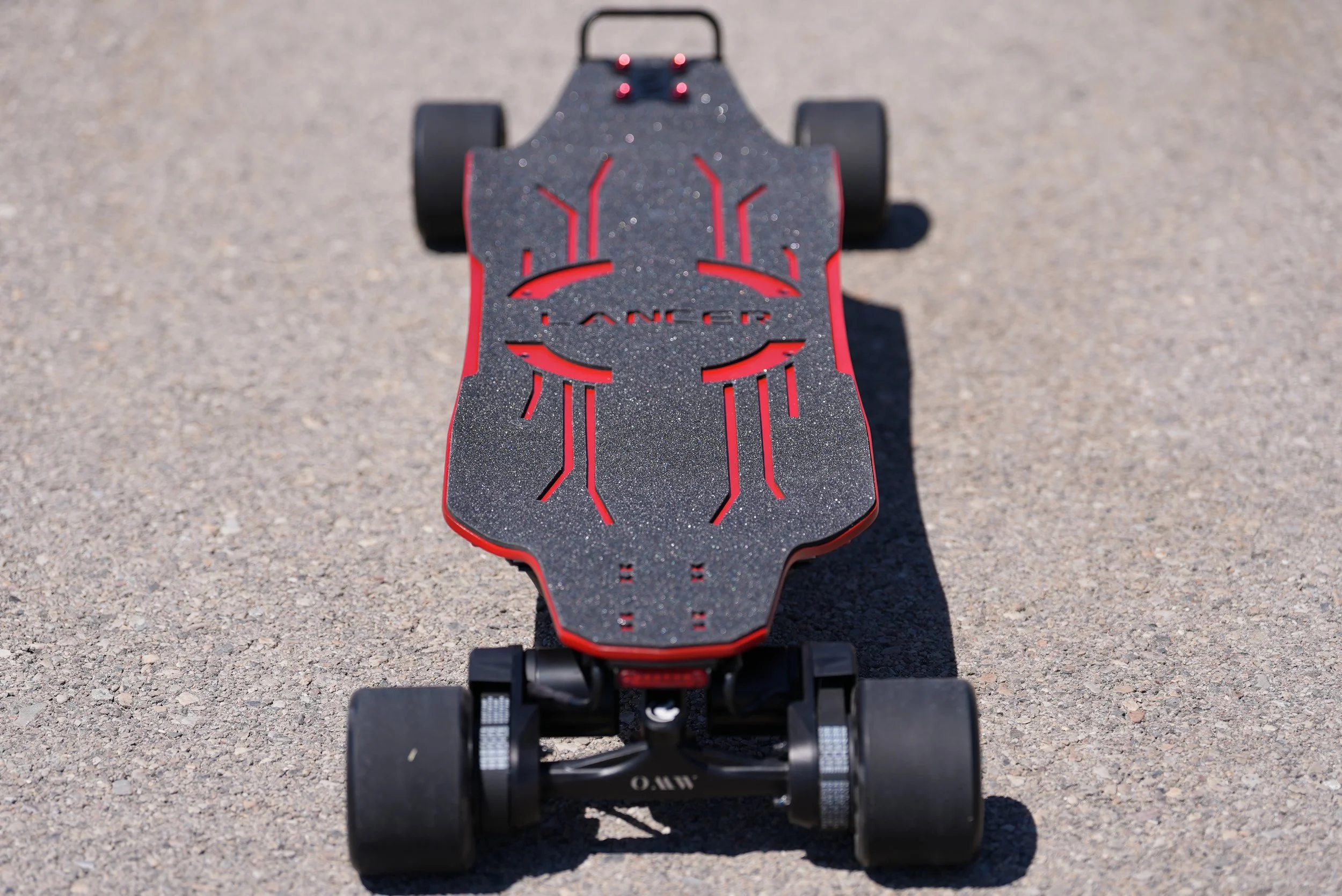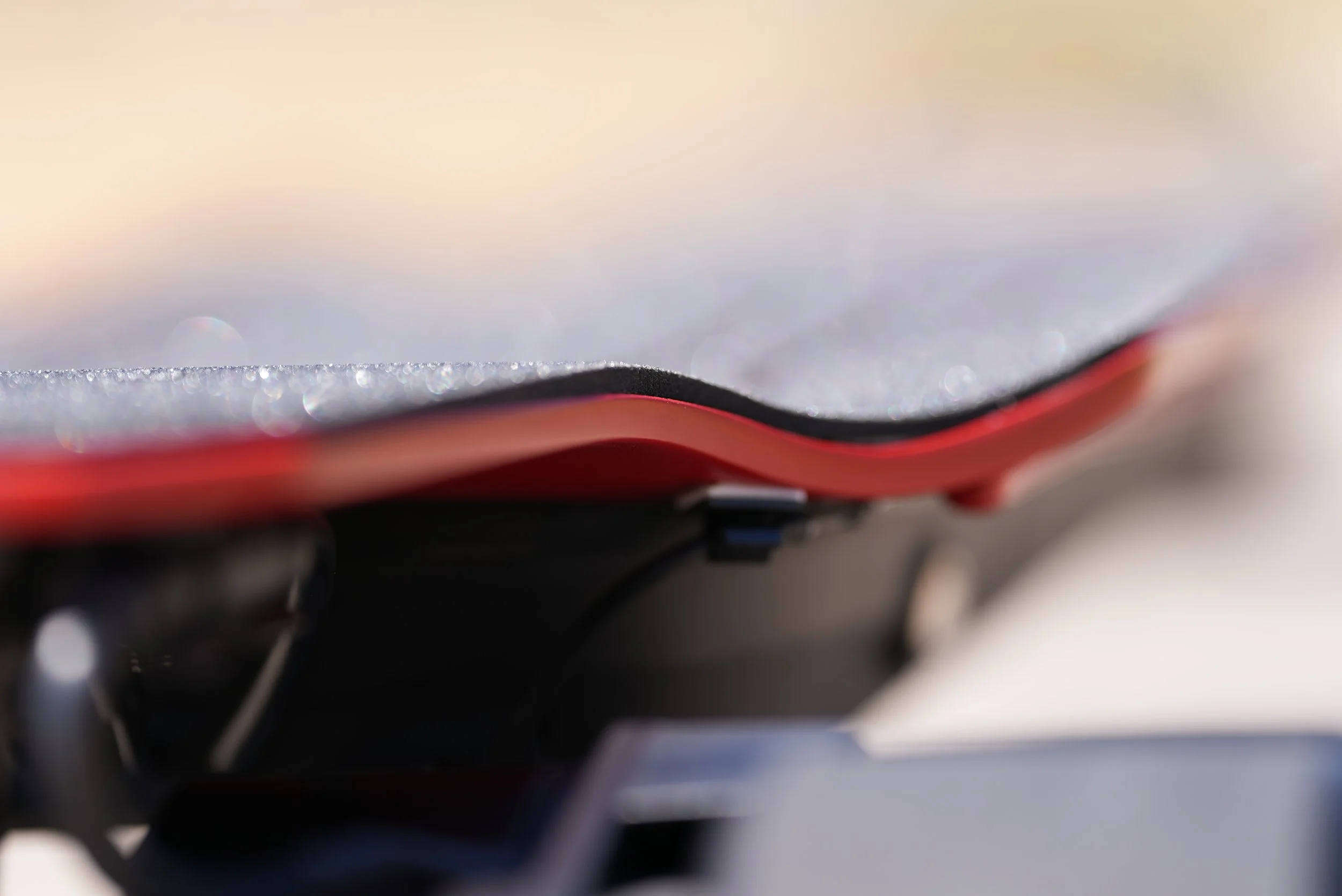OMW Lancer Electric Skateboard Review
I’ve spent some quality time with the O.M.W. Lancer electric skateboard with the standard 105mm “Mad Wheelz V2” setup, and I’m here to share my experience. This board has been generating a lot of hype as possibly the best electric longboard under $800, so I was eager to see if it lives up to those claims. Is the Lancer worth it, and who should buy it?
Design and Build Quality
Taking the Lancer out of the box, I was immediately impressed by its build. The deck is a 39.3-inch long, 10.2-inch wide carbon composite deck and yes, it actually flexes! Unlike many stiff carbon boards I’ve tried, the Lancer’s deck has a pleasant flex to it. O.M.W. achieved this by using a mix of carbon fiber, fiberglass, and epoxy resin in the deck. The result is a deck that’s thin but strong and slightly springy. In fact, O.M.W. is confident enough to offer a lifetime warranty on the deck, which speaks to its durability.
Visually, the Lancer stands out. Mine came in a bold blood red color, you can choose red or black, and I love that OMW went for an eye-catching look instead of yet another plain black board. The deck shape features a concave with a subtle W shape in the middle and drop-down areas at both ends. When I step on it, my feet feel locked in place that concave and drop-down give me a secure foothold, which is awesome for confident acceleration and braking. The grip tape on top is worth mentioning too: it’s padded foam grip about 3mm thick, which adds noticeable comfort by absorbing vibration
The Lancer rides on 9.25-inch forged TKP trucks with CNC-machined baseplates. “TKP” are known for quick turning and a surfy feel, yet they can be very stable when set up right. Out of the box, I noticed the trucks were mounted slightly farther inward from the nose and tail than on typical boards, and there are 1 cm riser pads under them. This design, combined with the wide deck, gives a very comfortable and stable ride. Little road bumps and cracks? The Lancer soaks them up like a champ, more on that in the ride section.
The wheels on my unit are the standard 105 mm “Mad Wheelz V2”. The board rolls butter-smooth over rough asphalt, pebbles, and small cracks without flinching. Honestly, these 105s are a sweet spot for urban riding. I felt like I didn’t need full pneumatic tires since the ride was already plush, and I didn’t have to worry about every little crack in the pavement. If you do want to go even larger, OMW offers 125 mm “Mad Max” wheels as an option. I haven’t tried those yet, but they’re compatible if you desire even more roll-over capability. Still, I found the 105 mm setup to be my favorite setup and strikes a great balance between comfort and maneuverability for city use.
The Lancer weighs in at about 26.5 lbs. That’s definitely on the lighter side for an electric street longboard. in fact, I’d say it’s about the lightest you can find a street board these days. Everything else is just bigger and heavier. Carrying it with one hand is manageable but you’ll feel the burn after a while. Thankfully, OMW includes a carrying handle that you can attach to the front truck area. With the handle, I can drag the board like a rolling suitcase or just get a better grip when lifting it, which is super handy.
Performance: Speed, Power, and Range
A 14S2P configuration using Samsung 50S 21700 cells, that’s 10 Ah, 504 Wh. Translation: higher voltage than typical boards, which helps with power delivery, and a healthy capacity for long rides. The battery is one of the Lancer’s crown jewels, it promises a lot of range, and in my testing it delivered plenty. OMW advertises 34 miles on a full charge, but that’s likely under ideal conditions. In my real-world rides, I got around 18 miles before hitting low battery. If you cruise gently in slower modes, I can see it reaching close to that 28+ mile claim. Either way, for a board under $800, this range is impressive. I didn’t have range anxiety on my typical rides at all. And when you do need to recharge, the included 58.8V 4.2A fast charger juices it up in about 2.5 hours, which is pretty quick for a 500 Wh pack. No overnight charging necessary here, a long lunch break and you’re almost full again.
The Lancer uses dual Hobbywing 4235 belt-drive motors, which OMW rates at 1764W total continuous and up to 2914W peak power combined. In plain English, these mid-size motors, around 5255 in outrunner terms, give the board a lot of torque and acceleration, especially paired with that high-voltage battery. The gearing is optimized for the wheel options: with the 105mm wheels it uses a 40T pulley which results in a gear ratio of 2.9:1. I was curious how a 14S system would feel, and I have to say the acceleration is smooth but strong for its price. From a standstill, the Lancer doesn’t jerk, it’s very controlled, but if you punch the throttle in highest mode, it’ll really get going fast. OMW claims a top speed of about 31 mph. I personally topped out around 29 mph on flat ground. That’s plenty fast for me. The board’s high-speed performance felt stable and confident, more on stability later, but I had no scary wobbles even near 30 mph, which speaks volumes about the setup.
At the heart of the electronics is a Hobbywing 9028 ESC, which is a 14S-capable speed controller with a Phase Current of 60A. Hobbywing is known for smooth control, and the Lancer’s throttle and braking certainly live up to that reputation. The acceleration curve is very refined, I could tap the trigger for gentle starts or push harder for quick launches, and it always responded predictably without cogging or jitter. The brakes are adjustable and regenerative. The remote is a standard Hobbywing OLED remote, with a clear little screen showing speed, battery, etc. Another neat feature: the ESC has a “smart on/off,” so the board powers itself on when you turn the remote on, no bending down to hit a power switch. Little conveniences like that add to the user-friendly feel.
I live in an area with some decent hills, and the Lancer absolutely eats hills for breakfast, lunch and dinner. It’s specced to handle up to a 38% grade incline, which is way steeper than any road I’d normally encounter. In practice, I charged up a long steep neighborhood hill around 20% grade and maintained around 25 mph without the motors struggling. If you’re worried about hills, don’t.
Riding Experience: Carving, Stability, and Comfort
This is where the Lancer truly shines in my opinion. The ride feel is buttery smooth and surprisingly “surfy” for a board of this size. The first thing I noticed was how stable it felt even at higher speeds. I attribute that to a few factors: the wide stance, the long wheelbase, and the tuned truck/bushing setup.
The bushings are a mix of a barrel and cone setup and are very hard: about 98A durometer up front and “55D” which is over 100A in the back. With the bushings loosened to a comfortable level, the Lancer’s character opened up, it went from feeling like a train on rails to feeling more like a nimble longboard that I could actually carve and maneuver easily. The sweet spot I found was having it tight enough to remain rock solid at 20 mph, but loose enough that I could lean in and get a nice carve at moderate speeds. In that configuration, the TKP trucks provide a lively rebound coming out of turns.
Speaking of flex, the deck’s flex adds to the ride comfort. It’s not super flexy, but it has a noticeable give that helps absorb shocks. I’d call it a medium to high level of flex, depending on your weight. Interestingly, OMW designed the Lancer so you can adjust the deck’s flex characteristics by moving the trucks to different mounting positions. There are three positions: a longer wheelbase option, making the deck effectively more flexible but turning slower. A shorter wheelbase, which feels stiffer but tighter turning, and the default middle option which balances both. I haven’t experimented with moving the trucks yet mine came in the middle, which felt great, but I love that the board has this modularity. It’s like having three boards in one, you could set it up looser and flexier for cruising or lock it in shorter if you plan to bomb hills and want extra precision. For me, the factory setting was a perfect Goldilocks zone: enough flex to be comfy, but still stiff enough for “pop” and responsiveness when I carve hard.
Now, let’s talk about road vibration and comfort. Thanks to those big soft 105mm wheels and the foam grip on the deck, the Lancer delivers a very smooth ride even on imperfect roads. The board just plows over small obstacles that would stop a lesser skateboard. This not only boosts comfort but also confidence: I wasn’t constantly worried about getting thrown by a random rock. It’s not an “all-terrain” board, but for an urban street longboard it comes pretty close in terms of not needing to constantly worry about what’s coming up.
The Lancer is definitely built for stability. It’s longer and heavier than the average longboard, and the TKP trucks are very resistant to speed wobbles. In fact, I experienced zero wobbles even when I pushed near top speed, the board tracks straight and true, and the rear truck’s stiffness really keeps the back end in line. This gives a lot of confidence when going fast. For very tight turning like zig-zagging or making a sharp 90-degree turn at an intersection, the Lancer is a little less agile than a smaller board no surprise given its wheelbase. For most riding, it felt plenty nimble, and if I needed more agility I could always loosen the trucks further at the expense of some high-speed stability. But unless you zooming in out of places packed shoulder to should, I don’t think the difference is that noticeable.
Features and Extras
The Lancer comes with a few quality-of-life features that I really appreciate. First off, it has a built-in LED tail light under the rear of the deck. This tail light is not just for show, it actually illuminates red when you brake, acting as a brake light, and it stays on as a running light at night. I do a lot of dusk rides, so having a stock tail light is awesome for safety, it saves me from strapping on a bike light or using a clip-on. The brightness is decent for visibility. In my testing I do think it’s not very bright during a sunny day. I would only trust it when the sun start going down.
OMW also offers optional front headlights and underglow RGB LEDs that can be added. The unit I received actually has these pre-installed, because it’s a review unit. But if you were to purchase one today, it comes separately and you have to install them yourself. The front headlights attach near the trucks and can be turned on via the remote, handy for nighttime rides if you need to see the road ahead. The underdeck RGB strip, once installed, gives you that cool underglow effect and you can cycle colors or patterns by triple-tapping the remote brake because who doesn’t want their board to look like a rolling TRON light cycle at night?. I played around with the RGB lights a bit, it’s a fun customization, though not something I’d use every ride. Still, for group rides or just showing off, having integrated underglow that’s controllable from the remote is a neat touch.
We already talked about the carry handle which is included and easy to attach/detach. It blends in pretty well and doesn’t get in the way when riding. Another small detail: the Lancer has an IP55 water-resistance rating. This as “splash-proof but not submersion-proof or jet-proof” You definitely wouldn’t want to ride any electric board in heavy rain if you can avoid it, including this one. But IP55 means the enclosure and seals should keep out dust and light water splashes. I got caught in a very light drizzle once and the Lancer was fine, but I did avoid puddles. It’s good to know it has some ingress protection, just don’t go testing fate in a downpour.
Lastly, I want to highlight the build quality of all the parts. The battery enclosure is well integrated and even features a metal heatsink for the ESC to keep things cool. Nothing rattles or feels cheap. The board feels like a premium product when you handle it, from the flush-mounted power button and charge port to the sturdy motor mounts. Sometimes budget boards skimp on little things, but the Lancer doesn’t give me that impression at all. Overall it comes across as a thoughtfully engineered package, not an assembly of random OEM parts.
Comparisons: Lancer vs. OMW Hussar and Cavalry
OMW Boards has a couple of other models, and as someone who’s also tried the OMW Hussar, and the Cavalry, I can share how the Lancer fits into the lineup. The Hussar and Cavalry are OMW’s all-terrain capable boards, whereas the Lancer is more of a dedicated street cruiser.
The Hussar is a 2-in-1 board that can run street wheels or pneumatic AT wheels. It has a slightly shorter deck than the Lancer, but still carbon and flexible, and interestingly OMW offers the Hussar deck in multiple flex ratings, so riders can choose a softer or stiffer deck based on weight. In contrast, the Lancer comes in one flex, with those adjustable truck positions to fine-tune it. The Hussar has a 12S3P battery or 648 Wh which actually gives it a bit more range than the Lancer, and a slightly higher top speed around 34 mph. It also typically ships with double-kingpin trucks for deep carving, although you can convert Hussar’s trucks to TKP as an option. Basically, the Hussar is aimed at riders who want the ability to go off-road with 6-inch or 7-inch pneumatic tires and want maximum range. It’s heavier than the Lancer and more expensive, but can be more versatile for mixed terrain. When I rode a Hussar, I noticed it felt taller off the ground (due to bigger wheels) and a tad less stable at high speeds with the DKP trucks (DKP are super fun for carving but can be twitchier at speed). The Lancer, with TKP trucks and a lower stance, felt more stable to me on pavement, and I actually prefer its handling for urban riding. If you need off-road capability, the Hussar is the better pick. But if you’re mostly on streets and bike paths, the Lancer’s ride felt more dialed-in for that purpose.
OMW Cavalry ($1499): The Cavalry is like the big brother, it’s a higher-end AT cruiser for long range and heavy riders. It boasts a massive 12S4P battery (864 Wh), huge 6374 motors, and comes stock with 7-inch pneumatic tires (with options to use 105mm or 125mm wheels in a 2-in-1 package). It’s designed for up to 330lb riders and to go really far (over 50 miles in ideal conditions on street wheels). The Cavalry also allows flex customization (different deck flex options) and uses DKP trucks by default (with an option to add TKP baseplates). The Cavalry is in a different class price-wise, about double the price of the Lancer, and it’s really for the enthusiast who wants an ultra long-range beast or needs the extra power for off-roading and high speeds (top speed ~37 mph). It’s also significantly heavier (I’d guess around 30+ lbs). I haven’t ridden the Cavalry, but from specs alone, the Lancer is clearly aiming at a different segment: more affordable, more street-oriented, and more moderate weight.
Where the Lancer fits: It feels like OMW took some of the best aspects of their AT boards (the flexy carbon deck, high-quality battery and electronics) and packaged them into a slimmer, street-optimized form with the Lancer. It’s also the most budget-friendly of the trio. I would recommend the Lancer to 90% of riders who ride on pavement and want a fun, high-performance board without spending a fortune. You get a taste of that high-end experience (carbon deck, high voltage power, long range) for a much lower price than the full AT boards. Unless you specifically plan to do a lot of off-roading or need 30+ mile range on the regular, the Lancer probably offers more than enough capability. On the other hand, if you’re an off-road junkie or you absolutely need the longest range and don’t mind a heavier board, then stepping up to the Hussar or Cavalry could make sense. For me, the Lancer hits a sweet spot in the lineup, it’s the “super street” board that focuses on carving, comfort, and portability (well, relative portability). It’s worth noting the Lancer is a new model (the “third board” from OMW, following Hussar and Cavalry) and it genuinely feels like they took feedback from the earlier models to improve the design. The wide deck, built-in lights, simpler single-truck configuration (TKP), and lower price all address things that many riders were asking for.
Final Verdict. Is the Lancer Worth It?
After logging miles on the OMW Lancer, I can confidently say yes, the Lancer is absolutely worth it for riders who want a high-quality longboard experience without breaking the bank. At around $749 on sale, be sure to use my coupon code to shave a few more dollars off of your purchase! And it supports my channel as well. It delivers an insane value: a flexy carbon deck, big 504 Wh battery with Samsung cells, smooth Hobbywing controls, 30+ mph speed, and a plush ride on 105mm wheels. It’s not often you see all those features together at this price point. In many ways, the Lancer doesn’t feel like a “budget” board at all; it feels like a top-tier board that could easily cost $1000+ from some bigger brands.
Who should buy the OMW Lancer? If you love carving and want that surfy feeling on an e-skate, the Lancer will put a huge grin on your face, it certainly did for me. It’s great for someone who maybe has tried cheaper boards and is looking to upgrade to a more capable longboard with better speed and range. It’s also a solid choice for a first high-performance board: the beginner mode is gentle enough that if you’re new, you can learn on this board, and as you gain confidence you won’t outgrow it anytime soon. Just keep in mind it’s a longboard, if your daily routes involve a lot of carrying up stairs or you need something ultra-light, you might consider a smaller board. But for day-to-day riding, the Lancer is an awesome “do-it-all” street machine.
Are there any downsides? Only minor ones in my book, and they’re mostly inherent trade-offs. The weight can be a factor if you have to lug it around a lot. Also, being belt-drive, it’s not as silent as a hub motor board, there’s a pleasant motor scream but some people prefer stealth. Maintenance-wise, belt drives mean you might eventually need to replace belts, but so far everything has held up perfectly and OMW provides spare hardware in the box.
In conclusion, the OMW Lancer has really impressed me. I was a bit skeptical of the hype, but in use it genuinely feels like a next-generation electric longboard. It blends comfort and performance in a way that I haven’t experienced in this price range before. Flying down the street at 30mph with confidence, carving up the bike path with ease, and not worrying about range or road vibrations. It’s the kind of board that makes you want to take the long route home just to keep riding. OMW set out to redefine what an under-$800 board can be, and I believe they succeeded. The Lancer is a fantastic choice for riders who want a premium ride without the premium price. In my opinion, it’s not just worth it, it’s a must-buy for 2025 if you’re in the market for an electric longboard that’s equal parts fun and value-packed.































